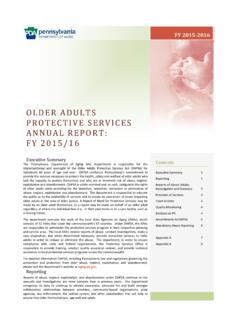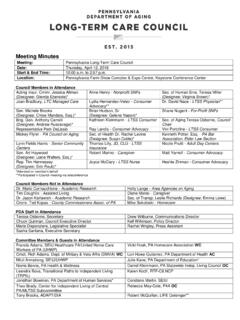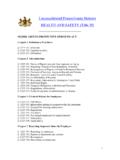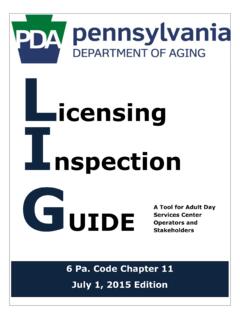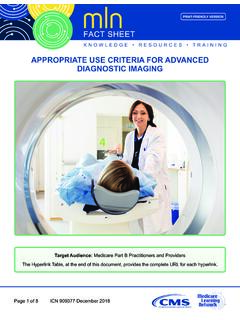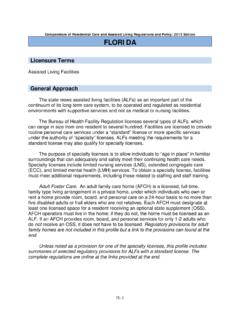Transcription of Level of Care Determination
1 Level of Care Determination 7/11/2013 Level of Care Determination 7/11/13 i Table of Contents Introduction .. 1 Course Description and Goals .. 2 Level of Care Definition .. 3 Level of Care Definition Overview .. 4 Guidelines When Determining the Level of Care .. 5 Tools for Conducting an Assessment .. 15 Conducting an Assessment .. 16 Boston University Assessor Training Modules .. 17 Assessor Roles and Responsibilities .. 19 Assessment Activity .. 20 Supervisor Roles and Responsibilities .. 27 Supervisor s Responsibilities .. 28 Quality Assurance .. 37 Level of Care Determination Form .. 41 Overview of the LCD Form .. 42 Summary of What s New and What s Changed .. 56 Supervisor s Role during Assessor Webinar .. 59 Supervisor s Role during the Assessor Webinar .. 60 Resources .. 61 OBRA Target Assessments .. 62 OLTL Bulletin 55-12-03.
2 65 Exhibit C Settlement Mosely vs. Alexander .. 69 Accessing the Boston University Center for Aging and Disability Education and Research Online Curricula .. 79 Mandatory Activities and Referrals .. 81 Mandatory Journal Topics .. 85 SAMS_80 Training Database .. 87 Custom Searches and Dashboard .. 89 Level of Care Determination 7/11/13 ii Quality and Compliance Unit Regions .. 93 On-Site Level of Care Monitoring Tool .. 95 SAMS Reports .. 97 Instructions for Completing the Level of Care Determination (LCD) Tool .. 99 Appendix .. 139 Level of Care Definition Case Study Key .. 140 Acknowledgements .. 146 1 Introduction Introduction 2 Course Description and Goals Course Description This course is designed to familiarize supervisors with the Level of care definition, tools for conducting an assessment, assessor roles and responsibilities, supervisor roles and responsibilities, and the Level of Care Determination Form.
3 Course Goals Review the Level of Care Definition and important guidelines for determining the Level of care. Discuss the tools needed to conduct an assessment. Review the role and responsibilities of the assessor in determining the Level of care, the completion of the Level of Care Determination Form and quality assurance measures. Review the role of the supervisor and their responsibilities in the completion of Level of care assessments, the Determination of Level of care and quality assurance. Review the new Level of Care Determination Form and instructions for completion. Describe the supervisor s role during the assessor training webinars. 3 Level of Care Definition Level of Care Definition 4 Level of Care Definition Overview Under Federal and State laws and regulations, which identify the Level of Care provided in a Nursing Facility, an individual should be considered Nursing Facility Clinically Eligible (NFCE) if the following criteria are met: 1.
4 The individual has an illness, injury, disability or medical condition diagnosed by a physician, and 2. As a result of that diagnosed illness, injury, disability or medical condition, the individual requires care and services above the Level of room and board, and 3. A physician certifies that the individual is NFCE, and The physician s certification (MA-51 or Script) is required as part of the Determination process and is used by the assessor in making a Determination regarding NFCE. The certification, in and of itself, is not the final Determination . 4. The care and services are either: Skilled Nursing or Rehabilitation Services as specified by the Medicare Program in 42 CFR (a), (b) (1) and (3), and through Health-related care and services that may not be as inherently complex as Skilled Nursing or Rehabilitation Services, but which are needed and provided on a regular basis through medical and technical personnel.
5 NFCE Level of Care Definition 5 Guidelines When Determining the Level of Care Important criteria for determining the Level of Care The individual has a diagnosis that requires treatment. The individual s diagnosis and treatment impact his/her physical and/or psychological ability to manage their own care. The individual s ability affects managing their care, treatments, and interventions. If the individual has a diagnosis of Alzheimer s disease, dementia, traumatic brain injury, or other mental health diagnosis, the Level of Care is based on the degree to which psychological problems are affecting the individual s functioning and the ability of that individual to maintain himself or herself in their environment. Deficits in Activities of Daily Living (ADLs) alone will not meet the criteria for NFCE.
6 The individual must have a medical condition that is currently being treated and creates a medical need that requires care and services of a health care professional. Deficits in Instrumental Activities of Daily Living (IADLs) alone will not meet the criteria for NFCE. The ability to perform IADL tasks can help an assessor determine the impact of physical and mental impairments, since performance of these tasks requires a combination of memory, judgment and physical ability. Focus on the Level of Care required (not Locus of Care) An individual who is assessed in a hospital or nursing facility may present well because they are receiving total care. The reverse may also be true. Because care is being provided, they are not doing what they may be capable of doing. Assessors must review hospital charts/nursing facility charts, and talk with hospital staff and family members.
7 Level of Care Definition 6 Gather information from various resources, including: Medical information Direct observation Demonstration of ADLs and IADLs Information from family and informal supports Input from the primary care physician (as needed) The Level of Care Determination is not just a self-report from the individual or family. Documentation must include: Summary of the assessor s direct observations Summary of the assessor s professional judgments and conclusions The basis for the judgments and conclusions that substantiate the Level of Care Determination Level of Care Definition 7 Review and consider the following case studies with your small group. Record your thoughts as you discuss each case study. Case Study #1 Sally Sally is a 50 year old female diagnosed with cerebral palsy.
8 She has generalized muscular weakness and tremors (tremors and spasticity are more prevalent in upper extremities) and acid reflux. As a result of these conditions, she requires monitoring of skin for signs and development of breakdown. Sally also requires oversight, administration and monitoring for adverse side effects of medications ordered by the physician, including over-the-counter medications and supplements for pain and discomfort. Sally requires hands-on assistance with all ADLs, including bathing, dressing, transferring, and toileting. She is unable to ambulate without hands-on assistance and a walker, but usually utilizes a wheelchair which must be propelled for her. She is functionally incontinent of bowel and bladder due to mobility issues and unable to assist with personal hygiene if an incontinent episode occurs.
9 Sally is unable to complete any IADLs without maximum hands-on assistance or total assistance. What is the Level of Care Determination ? What is this Determination based on? Level of Care Definition 8 Case Study #2 John John is a 62 year old male diagnosed with poor vision, hard of hearing (HOH), history of left hip fracture, edema in his feet, gastro-esophageal reflux disease (GERD), hyperthyroidism and anxiety disorder. He requires the use of a walker when ambulating and is able to self-transfer with the use of an assistive device. John requires hands-on assistance with washing his back and hair. He is able to independently dress himself and will usually wear clothing items that do not require being pulled over his head. John requires assistance with completing laundry, as he cannot carry more than 10 pounds.
10 He also requires assistance with grocery shopping. John is able to cook for himself and has an adaptive kitchen to address visual impairment. He manages his own medication that is pre-poured by the pharmacy in blister packs. John is alert and oriented to person, place and time and he is able to make his needs known and is able to make his own medical decisions. What is the Level of Care Determination ? What is this Determination based on? Level of Care Definition 9 Case Study #3 Josephine Josephine is an 80 year old female diagnosed with dementia and arthritis in both knees. She is oriented to self and occasionally to other familiar persons only. She confuses names and the relationship of others to herself. Josephine requires monitoring of all bodily functions due to an inability to recognize impairments.
